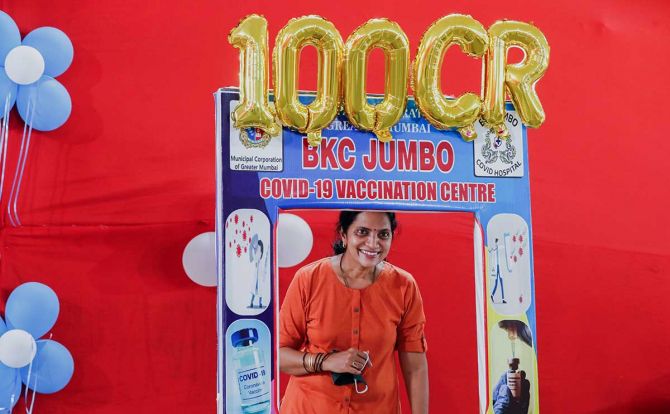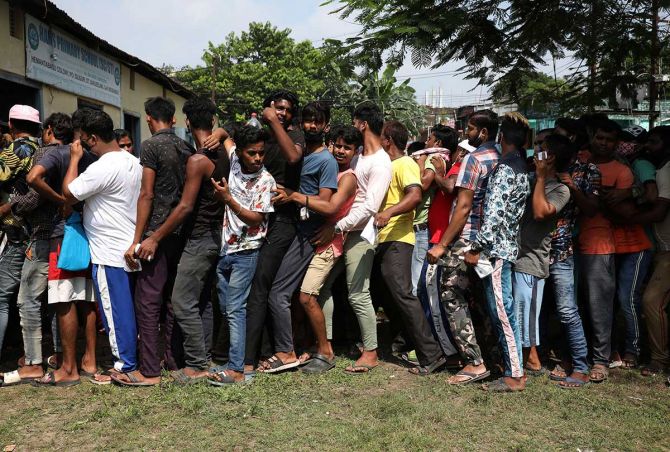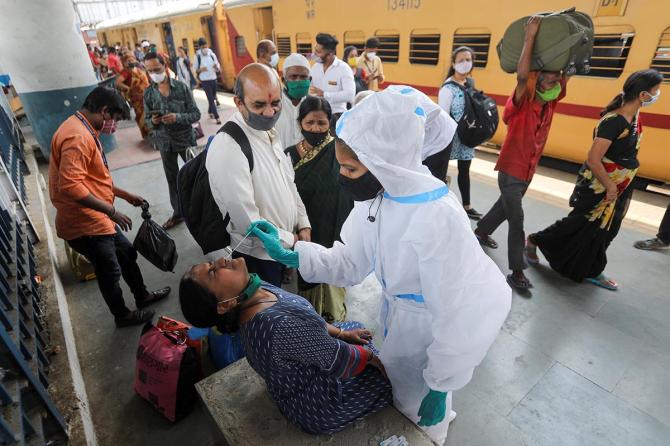The vaccination drive was only one important part of India's globally recognised pandemic management and response strategy, observes Dr Vinod K Paul, member (health), NITI Aayog.

In January 2021, India started rolling out a historic COVID-19 vaccination drive. Since then, over 2.2 billion vaccine doses have been administered.
India hit the astonishing figure of 2 billion doses in 18 months, making the effort truly unparalleled both in scale and speed.
We also created a record of administering 25.1 million doses on a single day, and of administering more than 10 million doses on nine other days.
What is even more remarkable is that the entire vaccination programme was powered by two made-in-India vaccines.
Over 97 per cent of the vaccines were provided free through the public health system.
Real-life data analysed by ICMR showed effectiveness of one- and two-dose vaccination to be 99 per cent and 99.4 per cent respectively in preventing mortality due to Covid-19.

A study published in the prestigious Lancet Infectious Diseases in September 2022 estimated the impact of the first year of COVID-19 vaccination worldwide.
The paper showed that as many as 3.4 million (range 2.75-4.88 million) deaths were averted in India by the vaccination programme in 2021 alone.
Now, a working paper released by the Stanford University and the Institute for Competitiveness (titled Healing the Economy: Estimating Economic Impact of Vaccination & Related Measures), while highlighting and using the above mortality reduction figure, has gone further to provide an estimate of income-generating potential of the vaccination programme.
The report estimates that the life-saving campaign yielded a positive economic impact by preventing the loss of $18.3 billion (Rs 1.29 trillion).
According to the paper, a net benefit of $15.42 billion (Rs 1.09 trillion) accrued to the nation after taking into consideration the cost of the vaccination campaign.

A related aspect has an important bearing at this point. The government procured the India-made COVID-19 vaccines for under $3 per dose.
The market price of the globally popular mRNA vaccines (Pfizer and Moderna), though varied, was typically about $20 per dose.
At such a price, the staggering cost of $40 billion (Rs 3 trillion) for two billion doses would have meant an enormous economic stress for the country.
In any case, there were simply not enough spare vaccine doses in 2021 in the global market to meet India's humongous need from any external source, and we would have been left high and dry if we did not have our own production.
Thanks to atmanirbharta, the country sailed through the crisis with its head held high by developing and delivering affordable and effective made-in-India vaccines.
We not only protected our own people, but also shared our produce with over 100 countries through the Vaccine Maitri initiative.

According to the Stanford paper, India set an example for emerging economies aiming to expand vaccination coverage across the length and breadth of the country.
With a strategic and prioritised vaccination drive and efficient coordination among the stakeholders, India proved that expanding vaccination coverage was not an insurmountable goal despite a range of challenges.
Further, the role of India's frontline health workers, especially the ASHAs, in the vaccination drive is a testimony to their importance in the healthcare system especially at the local level.
The report notes that ASHA workers served as the point of contact between the authorities and the masses.
They richly deserve the Global Health Leaders Award bestowed by the World Health Organization at the 2022 World Health Assembly.

The vaccination drive, however, was only one important part of India's globally recognised pandemic management and response strategy.
The paper elaborates the three cornerstones of India's strategy -- containment, relief package, and vaccine administration.
It observes that these three measures working in conjunction were critical in saving lives and ensuring uninterrupted economic activity by containing the spread of the Covid-19, sustaining livelihoods, and developing immunity against the virus.
India's pandemic management and response was bolstered further by acclaimed IT tools such as CoWIN, Aarogya Setu and eSanjeevani.
The Stanford report notes that robust measures at the ground level, like contact tracing, mass testing, home quarantine, distribution of essential medical equipment, revamping healthcare infrastructure, and constant coordination among multiple stakeholders at the Centre, state and district levels, helped contain the spread of the virus and prepare a massive hospital infrastructure for care.
It highlights that as against a top-down approach, a bottom-up approach was critical in containing the virus.
The Economic Survey (2020-w021) had shown that India was able to save more than 100,000 lives due to the lockdown in 2020.
It pointed out that because of this measure, the country took around 175 days to reach the peak from its first 100 cases, while many countries (Russia, Canada, France, Italy, Germany, etc.) reached their first peak in less than 50 days.
According to the Stanford report, the lockdown and subsequent containment measures helped flatten the curve and struck a balance between saving lives and sustained economic activity.

The calibrated approach used by India in formulating a comprehensive relief package, as opposed to a front-loaded stimulus package, played a major role in reducing the financial stress on the people and in ushering in a resilient post-pandemic trajectory.
With a comprehensive package that encompassed old people, women, farmers and the working class, the Pradhan Mantri Garib Kalyan Yojana (PMGKY) amounting to Rs 68,820 crore ($9.7 billion) ensured that the impact on the livelihoods of people was moderated to an extent.
According to the Stanford report, as a fiscal stimulus, the PMGKY had an economic impact of $7.57 billion (Rs 53,679 crore).
Under the PM Garib Kalyan Rozgar Abhiyan, 40 lakh beneficiaries were provided employment, which resulted in an overall economic impact of $4.81 billion (Rs 34,095 crore).
The PMGKY involved distribution of free food grains to approximately 8 million people, which ensured that no one slept hungry. It made a huge economic impact of $26.24 billion (Rs 1.86 trillion) according to the Stanford study.
The pandemic had devastating effects on the global economy.
Institutions such as the United Nations and the International Monetary Fund estimated losses of trillions of dollars.
For India, a country heading into higher orbits of its development and economic robustness, such a setback could have been catastrophic. Yet, India continues to be the fastest-growing major economy even after the pandemic.
Indeed, India has emerged stronger in the post-pandemic world under the leadership of the prime minister, having been successful in protecting lives and livelihoods, and in preserving the energy and dynamism of the nation's economy.
Views expressed are personal.
Feature Presentation: Ashish Narsale/Rediff.com











